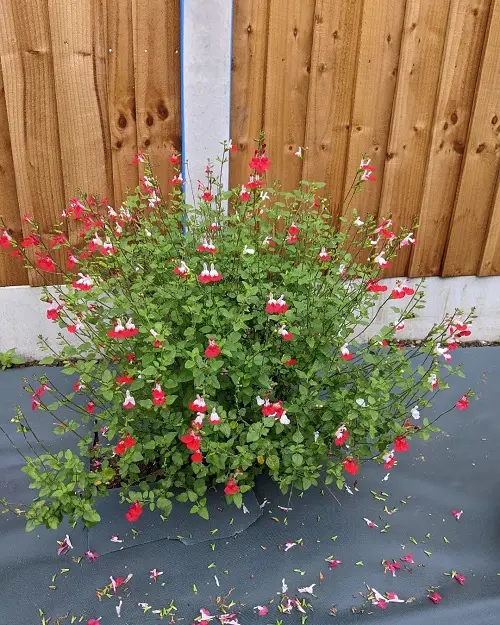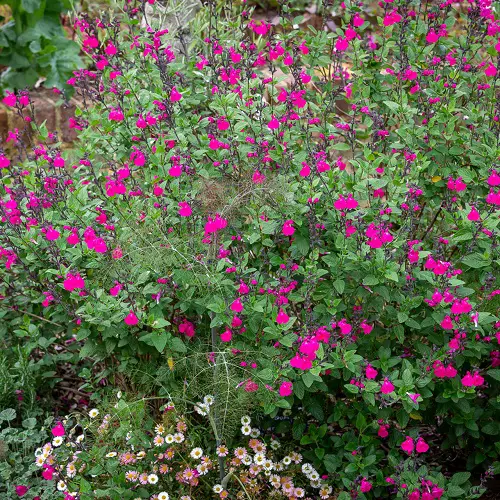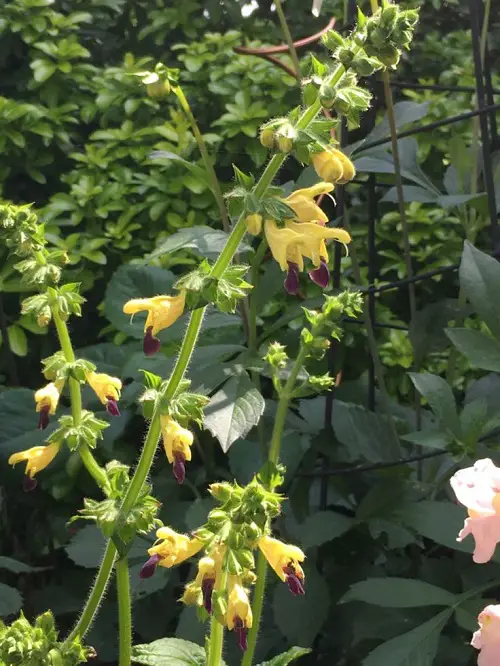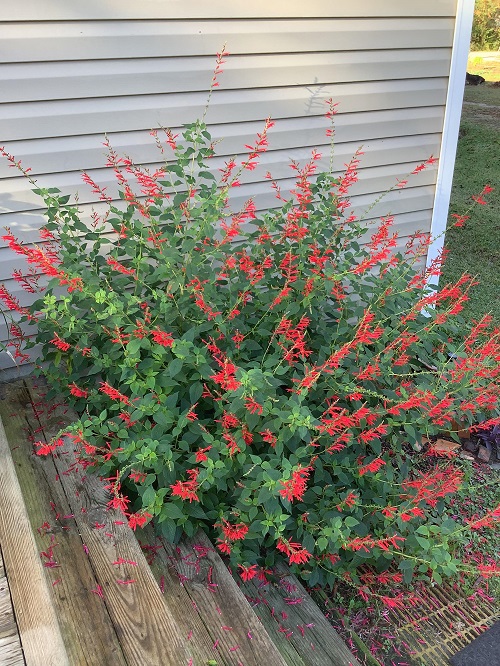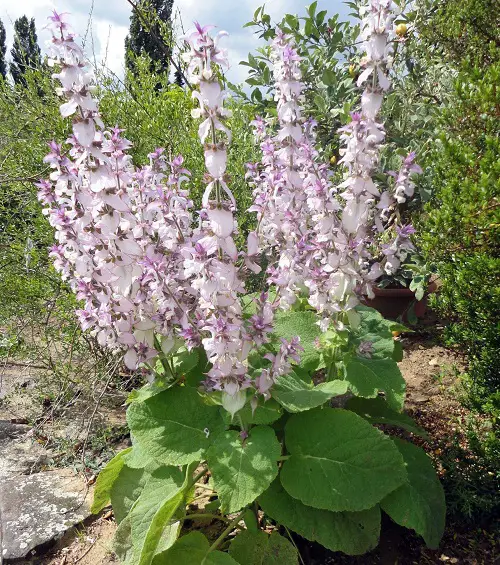Shrubby Salvias bloom the longest and Grow Big and Tall, giving the garden volume and a mosaic-like richness!
With cultivars for every season, shrubby salvias grow tall, big, and bouncy and produce long-lasting, nectar-filled blooms in pigmented hues—a magnet for bees, butterflies, and hummingbirds! Let’s explore.
Why Grow Shrubby Salvias?
Immaculate in any garden setting—borders, underplants to flowering shrubs like roses, mixed beds, and hedges—shrubby salvias are also superb container plants that thrive in patios, balconies, and windowsills.
Drought-tolerant, deer-resistant, and excellent companions to other vegetation, nearly all salvia varieties have leaves that give blackcurrant-to-minty fragrance when crushed and are effective at preventing fungal diseases and certain pests.
Thriving in light, free-draining soil, and ample sunshine, these big salvias may all not survive extreme cold except for a few varieties when the soil is frosty and wet. Winter is a good time to salvage your salvias and move the potted ones indoors. You could also back them up by saving cuttings!
Best Shrubby Salvias
In this article, we will explore the best shrubby salvias with exquisite, bushy foliage and flowers that often last 4-5 months, even into the first frost!
1. Hot Lips
Botanical Name: Salvia microphylla ‘Hot Lips’
USDA Zones: 8-10
Let’s kickstart our shrubby list with the hardy Salvia microphylla and dive into its popular Hot Lips cultivar! Growing over three feet tall and wide, this compact, bushy cultivar features spikes of beautiful white-red blooms and lip-shaped petals.
With scalloped, light green foliage, this heat-tolerant variety thrives in well-drained soil, tolerates both full sun and part shade, and is effective in mass planting, hedges, groundcover, or as an accent plant, and pairs well with the aromatic lavender.
2. Wild Watermelon
Botanical Name: Salvia microphylla ‘Wild Watermelon’
USDA Zones: 7-9
Another shrubby S.microphylla cultivar is Wild Watermelon, emerging from Cerro Potosi mountain in Mexico. Growing up to 3-4 feet tall and wide, this fruity-fragrant variety sports small leaves and tubular flowers in magenta that bloom from mid-summer to late fall.
Suitable for dry terrains once established, this cultivar attracts hummingbirds, honeybees, and hummingbirds, making it perfect for creating native, wildlife rich mini-habitats.
3. Autumn Sage

Botanical Name: Salvia greggii
USDA Zones: 6-9
How about a salvia sub-shrub that’s always in bloom? Native to North America, Autumn sage is another quintessential shrubby species that can grow up to five feet tall and wide, and blooms from March all the way to November.
S.greggii sports smooth-edged, minty leaves unlike S.microphylla’s ribbed ones, and boasts tall racemes of tubular blooms from pastel to deep shades of red, purple, pink, and orange. Check out shrubby cultivars like ‘Salmon,’ ‘Teresa,’ and ‘Furman’s Red‘ for bushy hedges.
4. Jame Sage
Botanical Name: Salvia × jamensis
USDA Zones: 8-12
Jame Sage is primarily a cross between microphylla and greggii, perhaps with some other species thrown in! It is a hardy shrubby salvia hybrid with small, aromatic toothed leaves and grows up to three feet tall and wide.
Popular cultivars include ‘Nachtvlinder’ with rich violet blooms, ‘Tangerine Ballet’ with sorbet hues in pink and orange, and several others! Thriving in well-draining soils, it is drought-tolerant once established, and easy to maintain.
5. Mexican Bush Sage
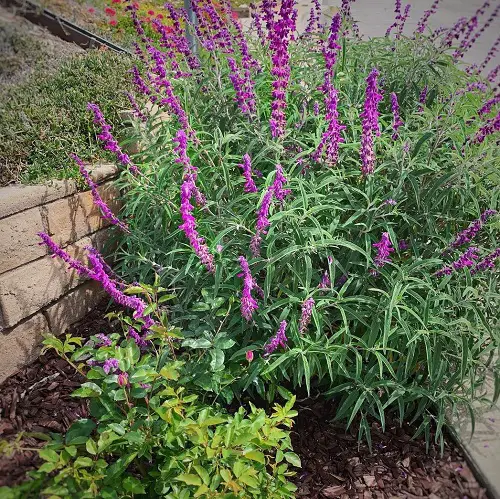
Botanical Name: Salvia leucantha
USDA Zones: 7-10
Now, this shrubby salvia isn’t all that cold-tolerant, and cannot withstand harsh winters! Mexican bush sage has arching stems and soft foliage that are a pretty gray-green to silver color, making for one of the best border plants.
Perfect for late-season container gardens, it produces stunning purple and white flowers that emerge from its mound-like velvety foliage, which can grow up to three feet tall. This variety likes plenty sun, and rich, well-drained, moist soil.
6. Jezebel
Botanical Name: Salvia ‘Jezebel’
USDA zones: 8-10
Jezebel is a tall hybrid sage that’s covered with bright pink-red flowers that bloom throughout the summer and fall. It’s great for rock gardens, beds, and containers and needs 6-8 hours of direct sunlight to thrive.
Make sure you plant it in well-drained, acidic soil. It’s also great for cut flower arrangements.
7. Purple & Yellow Yunnan Sage
Botanical Name: Salvia Bulleyana
USDA Zones: 5-9
This Chinese species from the Yunnan province features custard yellow flowers with purple-blue tips. The blooms tower over this variety’s soft, hairy, shrubby foliage, which reaches about two feet in height with a wider spread.
Tolerating extreme cold as well as heat, this sage enjoys a moderate bit of hydration unlike other varieties on this list. Plant it on garden borders, in containers, cottage gardens, and even in wildlife gardens—it’s versatile and easy to care for.
8. Pineapple Sage
Botanical Name: Salvia elegans
USDA Zones: 8-11
The Pineapple sage is a semi-woody, herbaceous shrub that has a clumping growth habit with open branches covered with yellow-green fuzzy leaves and serrated edges. There are many cultivars of the Pineapple sage, some of which can easily grow 5 feet in height.
If not grown in frost-free regions, these plants die back after hard frosts. However, they reappear in spring if the weather is mild enough. In colder areas, they can be grown as an annual, thanks to their fast growth habit.
9. Cleveland Sage
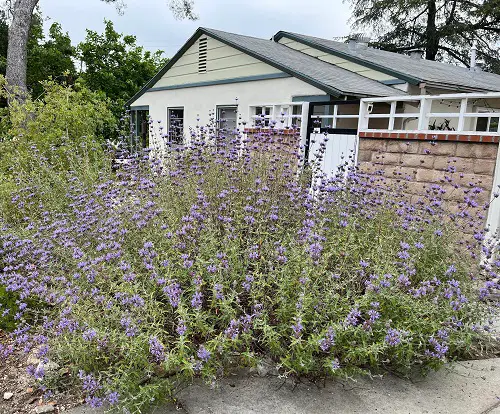
Botanical Name: Salvia clevelandii
USDA Zones: 9-11
This shrubby sage is well known for its spreading habit, growing up to four feet tall, but nearly eight feet wide! The foliage of Cleveland sage is gray-green, and it also has blue, purple, or lavender flowers on tall stalks that make it stand out.
It’s pretty low maintenance and needs about 6-7 hours of full sun like other salvia varieties. Not too much water, though.
10. Clary Sage
Botanical Name: Salvia sclarea
USDA Zones: 5a-9b
Clary sage is a short-lived perennial that’s cherished in the essential oil industry for its healing properties. It’s bigger than most on this list, easily crossing the 6-foot mark in height, and has bell-shaped flowers of pink and white.
This popular Mediterranean native thrives in full sun with moderate watering, and it’ll bloom from June to August.
Among many more sage varieties out there, these ones are sure to stand out in your garden! Let us know in the comments below which variety you go with.


